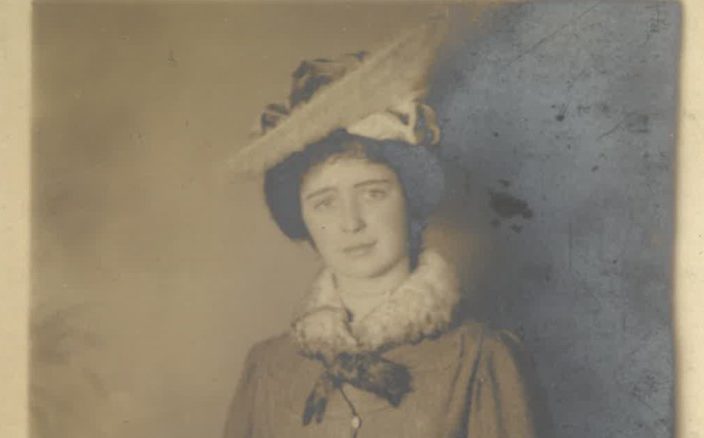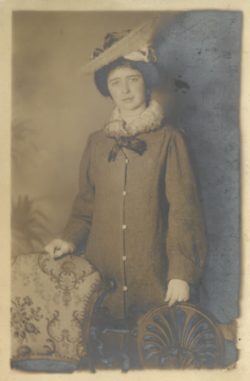My Huguenot Ancestors

A guest blog from Janet Coles
My maternal grandmother, Emily Maria Gaskin, was born in 1884 in London and died in York in 1956. She is the only grandparent I can remember and I was her only grandchild; though she died when I was seven, I have several fond memories of her kindness and of times we spent together.
I recall her as a tall, elegant woman with a quiet voice. Her hair was always in a neat bun and she wore hats with little veils which I found very interesting. She often dressed in smart tailored suits which she had made herself. She also made splendid dolls’ clothes. It was many years later while researching my family tree that I found out that she had acquired this expertise as a tailor and seamstress during her early years in the Bethnal Green area.
Emily and her older brother William Edward John Gaskin were baptised on the same day, 15 September 1886, in the Parish of Old Ford when the family were living at 7 Lyall Road, Mile End. The occupation of their father, William Samuel Pearce Gaskin is given as ‘teller’ but it appears that the original entry, crossed out, may have said ‘tailor’. No doubt the error was due to the much greater number of tailors entered in the register.
In the 1901 census William S.P. Gaskin is recorded as a ‘Teller of Stamps, Inland Revenue’ and his daughter Emily is a ‘Tailor – machinist trousers’. The census of 1911, however, shows Emily’s occupation as ‘teller – printing’ so it seems she had followed in her father’s footsteps. She was employed at the time by the De La Rue company who produced postage stamps and bank notes. By now she was lodging with a family named Hart in Monega Road, Forest Gate. Bertha Hart, daughter of the family, remained a lifelong friend of Emily’s.
For generations, Emily’s family had been employed as silk weavers or in related occupations in the same part of London. The 1841 census, for example, recorded that both Emily’s great grandfather William Sherrard (1812-1864) and his father John (1769-1852) were silk weavers in Bethnal Green. It is in fact possible to trace the family back much earlier, mainly through the extensive records held by the Huguenot Society of Great Britain and Ireland. The Society’s library holds over 6000 books and pamphlets, prints, engravings and genealogical files. There are details of baptisms, marriages and deaths from the French Churches in Britain and records from the French hospital in London. The Society also publishes a widely on all aspects of Huguenot history. One series Huguenot Families includes a brief account of A History of the Raby and Flawn families by C .J. S Flawn in issue 12, which has references to some of my ancestors.
The first wave of Huguenots arrived in Britain in the middle of the sixteenth century. They were Calvinists who were escaping from religious persecution in France and parts of what is now Belgium. A large group of refugees arrived in Britain in 1572 after the notorious Massacre of St. Bartholomew. In 1598 the Edict of Nantes granted Protestants in France some political and religious freedom, but when this was revoked by Louis XIV in 1685 numbers of refugees rose sharply. It was at this time that many settled in the area of Spitalfields, including sections of Bethnal Green, Shoreditch, Mile End New Town and Whitechapel. It has been claimed that some forty or fifty thousand came from France to Britain between the late 1670s and the first decade of the eighteenth century.
The earliest of the ancestors I have been able to trace on my maternal grandmother’s side lived in France in the seventeenth century. My ten times great grandfather Pierre Raby (1610-1660) and his wife Suzanne Rabier (d. 1660) lived in Marchenoir (Marché Noir) a village in Loir-et-Cher, not far from Blois. Their son Daniel Raby (1633-1666) and his wife Anne Presleux (about 1635-1680) lived in Marchenoir, but their son, also Daniel, (1658-1724) born in Marchenoir, emigrated to London. The date of his arrival is not certain but must have been in the latter part of 1687. On 23 October of that year the records of the Consistory of the French Church of London, Threadneedle Street, include ‘Daniel Rabbi of Marché Noir’ as being one of those who had ‘made reconnaissance’ that day. This was an obligation which each Huguenot refugee had to fulfil in front of the congregation at the French Protestant Church, describing his or her experiences before, during and after fleeing from France. The refugee could then be accepted fully into the Church.
According to the Huguenot Society, the refugees ‘... could not entirely escape the accusations levelled at immigrants from time immemorial - that their presence threatened jobs, standards of housing, public order, morality and hygiene and even that they ate strange foods’. However, this might have been mitigated to a certain extent by the unpopularity of French Catholics at the time. Within a hundred years of Daniel Raby arriving in Britain, many Huguenots were no longer an identifiable minority in the community, some abandoning Calvinism for Anglicanism. La Neuve Eglise, the Huguenot church on Brick Lane, Spitalfields, became a Wesleyan chapel in 1809. (It later became a synagogue and is now a mosque).
Daniel Raby died in the French Protestant Hospital in London on 3 May 1723/24. Eight generations later, when my grandmother Emily Maria Gaskin was born in 1884, the Spitalfields silk industry was in decline. However, there are regular guided tours of the area, visiting former houses of the master weavers and the smaller ones of journeymen weavers and tracing the development of the industry; I hope to join one of these tours later this year.

Emily Maria Gaskin aged 23
